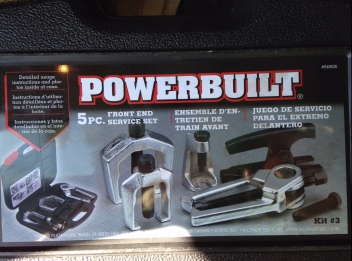What is a tie rod and why are its ends important? Tie rods connect a car’s steering mechanism to each front wheel.  If a tie rod fails, the driver loses control of the direction of the front wheels and therefore the car itself. As you can see to the right, tie rods are beefy and and they look unlikely to break.
If a tie rod fails, the driver loses control of the direction of the front wheels and therefore the car itself. As you can see to the right, tie rods are beefy and and they look unlikely to break.
Tie rod ends, however, are a concern because they need to articulate as the car turns and goes over bumps. The articulation point is a ball within a socket joint, similar to a hip. The ball is connected to a bolt (pointing down in the picture) that is attached to the car. It fits into a socket in the tie rod itself, thus allowing rotation and side to side pivot movements. Over time, the ball can wear away allowing unwanted flex and imprecise steering. Mechanics should test tie rods for excessive play and replace the ends if necessary.
Servicing a tie rod involves four steps: remove the tie rod, replace the ends, and then replace the repaired part in the car. The last step is to check the alignment of the front wheels.
The first step can be problematic because, even with the securing  nut removed, the tie rod can be stuck. The bolt itself is tapered slightly and fits into a cone shape in the steering arm. This arrangement helps hold the parts together tightly. Sometimes they can be separated with a hammer tap, but sometimes a special press is needed to do the job. Fortunately, some auto parts stores lend specialized tools. The kit pictured to the right includes five tools that squeeze or press tie rod ends and ball joints.
nut removed, the tie rod can be stuck. The bolt itself is tapered slightly and fits into a cone shape in the steering arm. This arrangement helps hold the parts together tightly. Sometimes they can be separated with a hammer tap, but sometimes a special press is needed to do the job. Fortunately, some auto parts stores lend specialized tools. The kit pictured to the right includes five tools that squeeze or press tie rod ends and ball joints.
In the next picture, a c-clamp device  fits around the steering arm. As the bolt at the top is turned, pressure is applied to the tie rod bolt. In this case, it came out with a satisfying crack. Putting in the new part is easy: install the nut and tighten.
fits around the steering arm. As the bolt at the top is turned, pressure is applied to the tie rod bolt. In this case, it came out with a satisfying crack. Putting in the new part is easy: install the nut and tighten.
With the new tie rod ends installed, it is time to align the front wheels. As mentioned, the tie rods connect the car’s steering to the front wheels and if not correctly adjusted, the car will be duck-footed or pigeon-toed. In the first picture in this post, you can see the left tie rods connected to a steel shaft. Turning the shaft adjusts the distance between the tie rods and thus the toe measure of the car. I measured the original length between the tie rods and tried to reproduce this distance with the new parts to get the adjustment close.
Why is the toe adjustment important? If the front wheels are skewed left of right, the car will not track in a straight line. Also, skewed wheels can cause tire wear. Although the Sunbeam drove well, it looked to me like the right wheel was turned inward slightly. An alignment was in the cards.